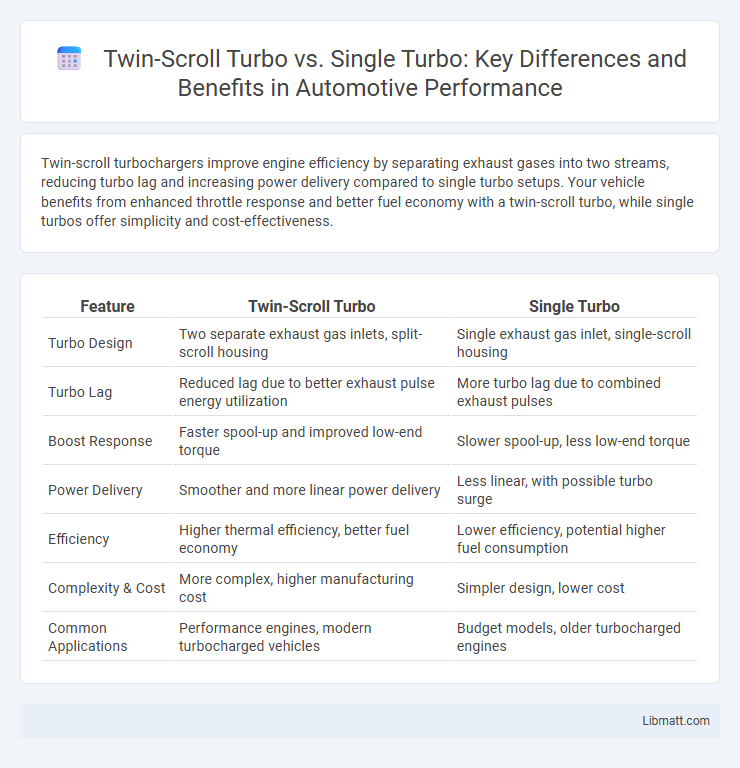Twin-scroll turbochargers improve engine efficiency by separating exhaust gases into two streams, reducing turbo lag and increasing power delivery compared to single turbo setups. Your vehicle benefits from enhanced throttle response and better fuel economy with a twin-scroll turbo, while single turbos offer simplicity and cost-effectiveness.
Table of Comparison
| Feature | Twin-Scroll Turbo | Single Turbo |
|---|---|---|
| Turbo Design | Two separate exhaust gas inlets, split-scroll housing | Single exhaust gas inlet, single-scroll housing |
| Turbo Lag | Reduced lag due to better exhaust pulse energy utilization | More turbo lag due to combined exhaust pulses |
| Boost Response | Faster spool-up and improved low-end torque | Slower spool-up, less low-end torque |
| Power Delivery | Smoother and more linear power delivery | Less linear, with possible turbo surge |
| Efficiency | Higher thermal efficiency, better fuel economy | Lower efficiency, potential higher fuel consumption |
| Complexity & Cost | More complex, higher manufacturing cost | Simpler design, lower cost |
| Common Applications | Performance engines, modern turbocharged vehicles | Budget models, older turbocharged engines |
Introduction to Turbocharging Technology
Twin-scroll turbos improve engine efficiency by separating exhaust pulses, enhancing turbo spool time and reducing lag compared to single turbos that use a single exhaust flow path. By optimizing exhaust gas flow dynamics, twin-scroll turbos boost low-end torque and overall power output more effectively. Single turbochargers are simpler and cost-effective but generally deliver less precise airflow management and slower response.
How Single Turbochargers Work
Single turbochargers operate by channeling exhaust gases through a single turbine housing to spin a compressor wheel, which then forces more air into the engine's intake, increasing power output and efficiency. This simple design delivers a steady boost across the RPM range but may suffer from turbo lag at lower engine speeds due to less efficient exhaust gas flow. Understanding how your single turbocharger functions can help optimize performance tuning and maintenance for improved driving dynamics.
Understanding Twin-Scroll Turbochargers
Twin-scroll turbochargers improve engine performance by using two separate exhaust gas inlets and nozzles to optimize the flow of exhaust pulses, reducing turbo lag compared to single turbos. This design enhances boost pressure and efficiency by maintaining exhaust pulse energy, leading to better throttle response and increased power output at lower RPMs. Your vehicle benefits from improved torque delivery and fuel efficiency when equipped with a twin-scroll turbocharger instead of a traditional single turbo setup.
Key Differences: Twin-Scroll vs Single Turbo
Twin-scroll turbos feature two separate exhaust gas inlets and nozzles, improving exhaust pulse separation and reducing turbo lag compared to single turbos that use one inlet. This design enhances low-end torque and throttle response while maintaining high-end power efficiency. Single turbos offer simpler construction but are generally less efficient in managing exhaust flow dynamics, leading to slower boost onset.
Performance Comparison: Power and Efficiency
Twin-scroll turbos optimize exhaust gas flow by separating pulses into two scrolls, significantly improving spool time and reducing turbo lag compared to single turbos. Your engine benefits from increased power output and enhanced fuel efficiency due to better scavenging and reduced energy loss. This design results in faster boost response and higher torque at lower RPMs, offering superior overall performance for both street and track applications.
Turbo Lag: Reduction and Response Times
Twin-scroll turbos significantly reduce turbo lag by efficiently utilizing exhaust pulses through separate scrolls, ensuring faster spooling and improved response times compared to single turbos. This design maximizes exhaust energy, allowing your engine to achieve boost pressure more quickly and deliver power with minimal delay. Single turbos, while simpler, often suffer from slower spool-up due to combined exhaust flow, resulting in longer turbo lag and less immediate throttle response.
Cost and Complexity: Installation and Maintenance
Twin-scroll turbochargers generally incur higher costs and greater installation complexity compared to single turbo setups due to their advanced design requiring precise exhaust gas flow separation and specialized manifolds. Maintenance demands for twin-scroll turbos are typically more involved, often necessitating more frequent inspections and specialized knowledge to address potential issues related to the divided exhaust channels. Single turbo systems offer simpler installation and easier maintenance, making them more cost-effective choices for budget-conscious vehicle owners or those seeking straightforward engine upgrades.
Applications in Modern Vehicles
Twin-scroll turbochargers improve engine efficiency and responsiveness by separating exhaust pulses, making them ideal for modern vehicles requiring enhanced fuel economy and reduced turbo lag. Single turbos, while simpler and more cost-effective, are commonly found in older or entry-level models where budget constraints outweigh performance demands. Your choice between twin-scroll and single turbo influences vehicle performance, emissions, and driving experience in various automotive applications.
Pros and Cons: Twin-Scroll vs Single Turbo
Twin-scroll turbos improve exhaust gas flow by separating pulses, resulting in faster spool times, better low-end torque, and reduced turbo lag compared to single turbos. Single turbos tend to be simpler, cheaper, and easier to maintain but may experience more lag and less efficient power delivery at lower RPMs. Your choice depends on balancing performance needs with budget and complexity considerations.
Which Turbocharger is Best for You?
Choosing between a twin-scroll turbo and a single turbo largely depends on your vehicle's power needs and driving style; twin-scroll turbos offer improved exhaust gas flow separation, resulting in faster spool-up times and reduced turbo lag, making them ideal for daily driving with quick responsiveness. Single turbos provide a simpler design with a single exhaust gas inlet, often delivering more peak power at higher RPMs but with increased lag, suited for applications prioritizing maximum top-end performance. Analyzing factors such as desired torque curve, engine displacement, and intended use will help determine which turbocharger best matches your performance goals.
Twin-scroll turbo vs Single turbo Infographic

 libmatt.com
libmatt.com